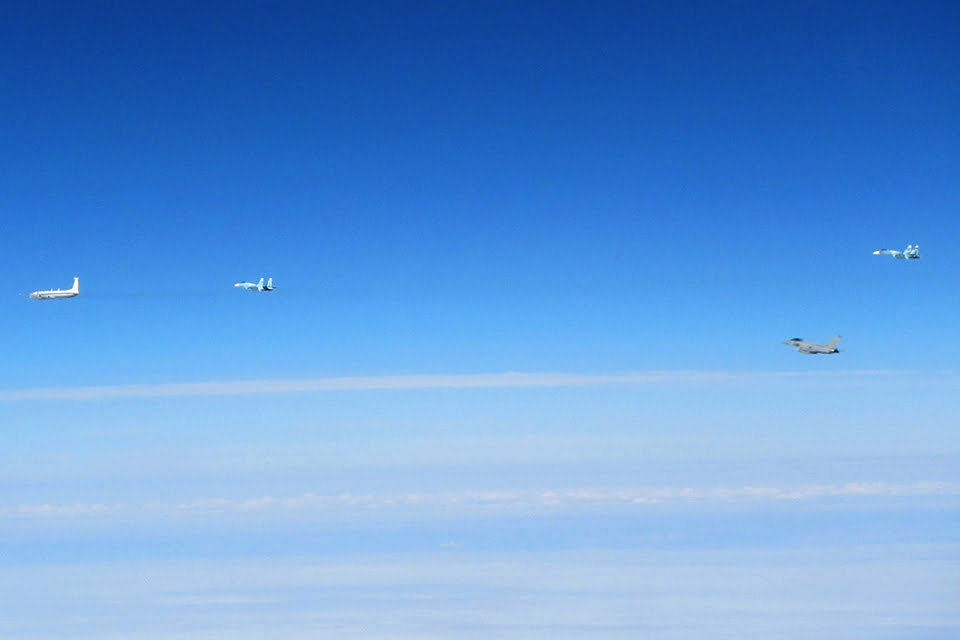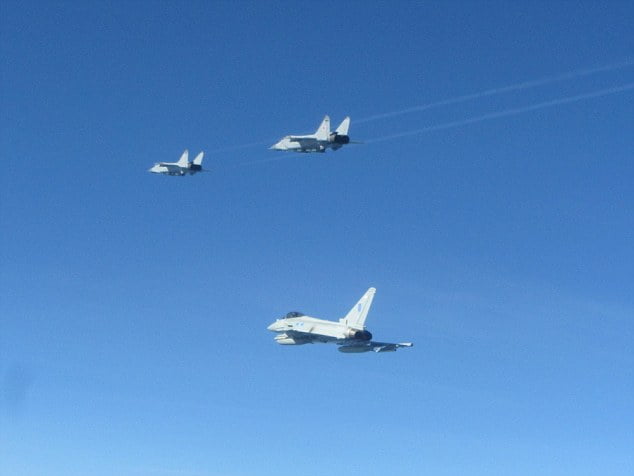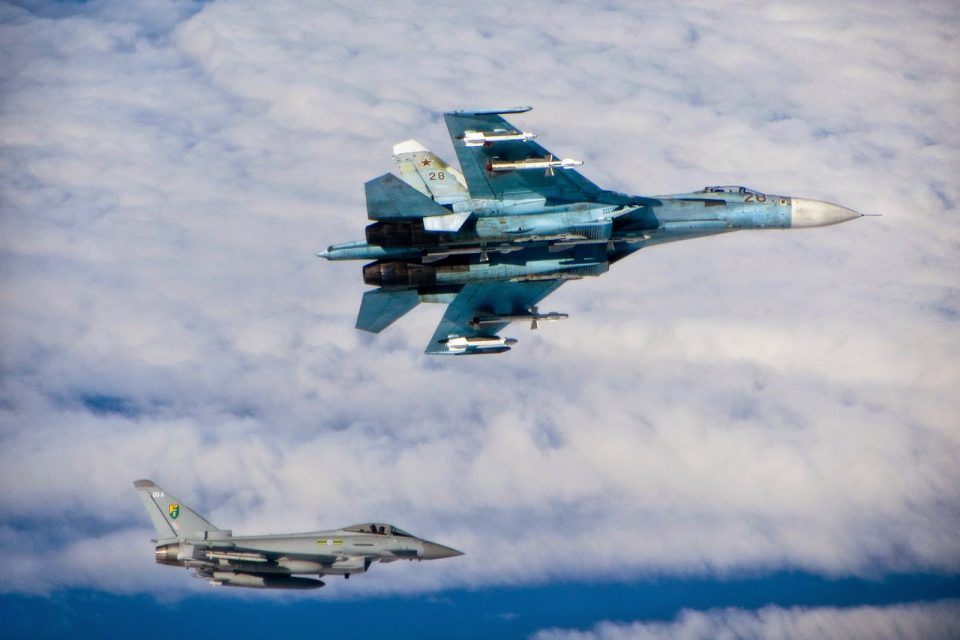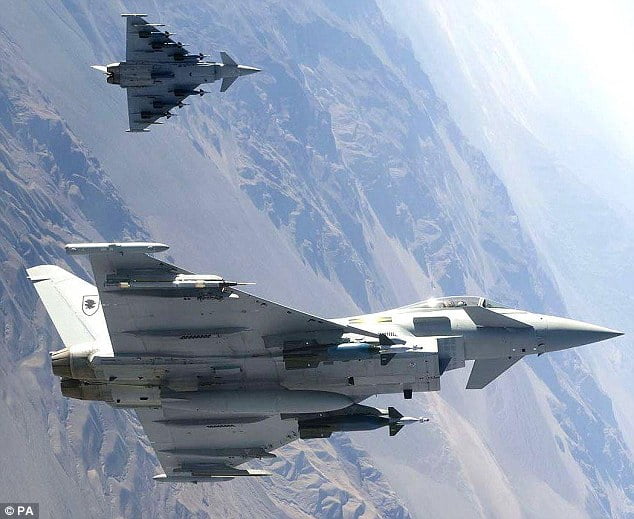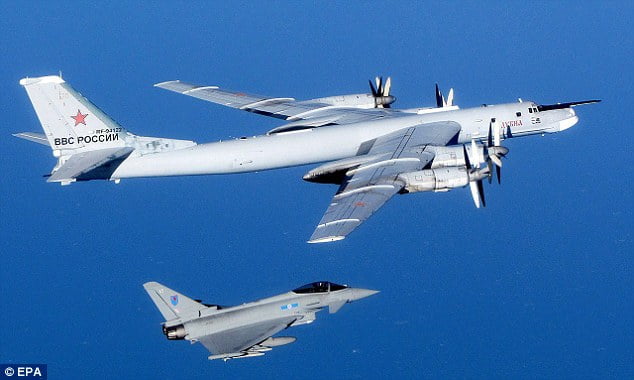2016-11-10 By Robbin Laird
During my visit to RAF Lossiemouth in April 2016, I had the chance to talk with OC II(AC) Sqn, the commander of one of world’s oldest and most famous squadrons.
He was the squadron commander who led the transition from RAF Marham to Lossie in 2014.
As the Wing Commander described the situation at Lossie:
“This was a Tornado squadron. Typhoons first arrived at Lossiemouth in 2014, with their arrival from Royal Air Force Leuchars in Fife.
When that air base closed, number one and six squadrons moved up from Leuchars, and then in January 2015, we re-rolled from Tornado to Typhoon and moved to Lossiemouth from Marham in Norfolk.”
Lossie is becoming a key Typhoon hub from which the jet is deployed worldwide.
This is placing a significant stress on the hub to support several concurrent forward deployments, a subject discussed with the Wing Commander as well as the Chief Logistics and Engineering Officer at the base in a later interview as well.
Question: How would you describe your mission?
OC II(AC) Sqn: We are a Quick Reaction unit at RAF Lossiemouth .
When conducting Baltic air policing, the key is to learn the template or approach to air policing and to work that with our NATO partners so we can seamlessly pass that mission back and forth to the NATO nations who perform the mission on a rotating basis.
It is a NATO mission and the NATO procedures have to be followed, learned and refined in executing the mission.
This is the third time that the Typhoon UK force has done the mission and is basically a quick reaction mission but in a NATO context.
It’s a very focused, dedicated NATO mission.
It is a great learning experience for everyone in how NATO works and how NATO operates.
Quick reaction alerts are a zero to hero mission in a period of minutes.
You can be asleep, completely asleep, dressed up, ready to go; and the engineers will be asleep; and yet, a number of minutes later, you are mandated to be airborne and facing a potential threat, facing a potential escalating situation, and you just don’t know.
You need to have everyone trained, and everyone in the mindset that they have to be ready to go all the time.
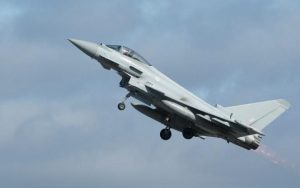
You need to do your job as professionally as you can when you get there.
You need to make sure that you’re following all the protocols that we have.
It is challenging.
Question: One challenge you face is that when you go on a mission, bombing in Libya or air policing in the Baltics, your pilots are honing their skills in one area.
How do you deal with the challenge of training with other proficiencies?
OC II(AC) Sqn: That is a problem.
When you’re out on operations, you’re just doing that single thing. You’re not practicing all the other skill sets; and it’s not like riding a bike.
It is like playing a musical instrument.
Getting people to keep current on lots of different mission sets whilst being deployed is a challenge.
And we are expanding our training systems with regard to synthetics as a key way to try to enhance our multi-mission proficiencies.
Question: This is also significant as you end the Tornado era and operate Typhoon as a multi-mission asset.
How do you see this challenge?
OC II(AC) Sqn: It is a challenge.
There are two different roles for a pilot, control the air and attack; but anyone should be doing both at the same time.
But with the Typhoon doing a multi-role mission we are now taking the two people in the cockpit in the Tornado and relying on only one in the cockpit now to transition among the mission sets.
When we’re teaching swing role, and taking people through swing role mindset, I often see people writing, “Get the bombs on target, and then deal with the rest of the mission.”
Actually, that is not the philosophy at all.
The philosophy is that we are an air system, an integrated air system.
You need to control that air space before you can do anything, be that take photos or get bombs on target
Our entire mission, our raison d’etre, is to control the airspace that we want to operate in, before we even do anything else.
It’s not a mindset change, really, but it’s more of a discipline change, in that “I want to prioritize different things at different times.”
Doctrinally there is a distinction between Control of the Air and Attack, but Control of the Air is the First Among Equals.
No one conducts surveillance, no-one delivers airborne troops and no-one responds to a TIC until we have established the necessary Control of the Air.
We instill in the guys that we train to always think about Control of the Air.
Question: I would like to turn to your experience with Typhoon.
The recent trilateral exercise at Langley brought together two airplanes which now have 10 years of operations under their belt along with Rafale which is a bit older, but the point is that it takes time to get the full combat capability out of a combat jet.
How do you view Typhoon at 10?
IIOC (AC) Sqn: I’ve been lucky to fly the aeroplane for all 10 of those years.
It is fantastically rewarding and satisfying but it has taken those 10 years to get there!
It will take another 10 years to bring in all of the other new equipment that we’re looking forward to incorporating into the jet.
I do think that the British are driving the equipment program because the British have the greatest political imperative to make it work of any nation in the consortium.
We like to think we bring performance in terms of fighter-to-fighter against a Russian threat.
We bring performance and we bring deterrence.
Those are the two things that we bring.
It’s a large aircraft in the F-15 class so we have endurance and a large payload.
Combine that with our performance and we bring a lot to the fight.
What we also bring is that we are different to the F-series fighters.
Having a fourth-fifth gen force mix allows plenty of scope for innovation and great tactical benefit.
We have different sensors and capabilities to the F-jets, as does Rafale, so any potential adversary would have to defeat a number of networked sensors.
We are however looking at new generations of Russian aircraft.
We are looking at upgrades of Russian aircraft we’ve been looking at evolving Russian SAM systems for years.
But it is not just about showing up.
What are they doing with that Russian aircraft?
How many have they got?
I do think that Typhoon brings to the modern combat air party a very capable, large weapons platform with plenty of room for expansion.
What I particularly like in terms of comparing it against Russian aircraft is that I bring performance, and I bring size and scale.
That’s what I really like about it.
Question: The squadrons at Lossie are operating worldwide, what strain does that put on the hub at Lossie?
OC II(AC) Sqn: One great advantage about being deployed is that you get full support in the field, often better than we would get at home.
Therefore every deployment puts greater pressure on ‘the hub’ to provide forward sustainment.
The challenge of delivering training and delivering serviceability to the variety of micro Typhoon fleets is a significant one.
Editor’s Note: A brief history of No. II (AC) Squadron with AC standing for Army Cooperation, hence the knot in its squadron emblem, is provided on the RAF website.
II(Army Cooperation) Squadron was formed at Farnborough on 13 May 1912 as one of the original Squadrons of the Royal Flying Corps (RFC). It quickly gained a pioneering reputation as it set the British altitude record of 16,000ft in August 1913 and, in August 1914, deployed the first British fixed-wing aircraft to fight in a war as the Squadron deployed to France.
World War I
The Squadron deployed to France with the R.E.1 and was later equipped with the B.E.2, Vickers FB5 and Bristol Scout. It initially performed reconnaissance duties but as technical innovations rapidly advanced, II(AC) Squadron increasingly acted in an air-to-surface attack role.
On 26 April 1915, whilst conducting a raid on Courtrai, 2nd Lt Rhodes-Moorhouse became the first airborne recipient of the Victoria Cross (VC), which was awarded posthumously.
A second VC was awarded to 2nd Lt Mcleod in April 1918 after he shot down 3 Fokker Triplanes and crash landed his damaged aircraft between lines before dragging his observer to safety from the wreckage.
It was in 1916 that the Squadron began painting black triangles on the fuselage, which were later painted white, as a means of friendly identification to ground troops. To this day, the white triangles remain as the Squadron symbol.
Inter-War Years
On its return to the UK, II(AC) Squadron was soon conducting Army Cooperation activities in Ireland and in 1927 it deployed to China where it operated the Bristol F2.B fighter from Shanghai racecourse. In 1931, the Hereward knot was approved for use on the Squadron crest symbolising its close relationship to the Army.
World War II
At the outbreak of World War II, II(AC) Squadron was operating the Lysander aircraft in a reconnaissance role as well as performing supply drops and inserting Special Operations Executive (SOE) Agents into occupied France. In August 1941 it was equipped with the Tomahawk as the Lysander had become inadequate in the reconnaissance role and the Squadron proved the utility of fighter aircraft as a photo-reconnaissance platform.
In 1942 II(AC) Squadron was re-equipped with the P-51 Mustang which it operated in tactical reconnaissance sorties in the D-Day landings in 1944. The Squadron flew 36 sorties on D-Day and it was a II(AC) Squadron aircraft that brought back the first aerial photographic images of the landings.
II(AC) Squadron supported the Canadian Army as they advanced through Europe and saw out the war with later marks of the Spitfire.
Cold War Years
After World War II, the Squadron moved to Germany where it spent 47 years before moving to RAF Marham with the Tornado GR1A. The years in Germany saw II(AC) Squadron operate Swifts, Hunters, Phantoms and Jaguars in a number of large NATO exercises as well as deploying on exercise to El Adem in Libya in 1963.
Post-Cold War Years
In 1991, II(AC) Squadron conducted sorties in support of Operation DESERT SHIELD over Iraq and in 1999 it policed the No-Fly Zones of Northern and Southern Iraq. It then deployed twice more to Iraq in 2003 and 2005 as part of Operation TELIC flying the Tornado GR4.
Following the retirement from service of the Harrier GR9, the Tornado GR4 began to operate in Operation HERRICK from Kandahar airfield in Afghanistan.
II(AC) Squadron performed several tours of Operation HERRICK until British forces withdrew at the end of 2014. The Squadron also sent aircraft to Operation ELLAMY in Libya, performing long-range sorties from their base in RAF Marham.
Present Day
On 9 January 2015, II(AC) Squadron became the fifth front-line Typhoon squadron and is now based at RAF Lossiemouth. It contributes to the Quick Reaction Alert (QRA) mission of the Station, which maintains a high state of readiness 24 hours a day, 365 days a year in the defence of UK airspace. The Typhoon is a multi-role capable combat aircraft and the Squadron prepares to deploy on contingency operations around the globe as well as participating in large international exercises such as Red Flag.
http://www.raf.mod.uk/organisation/2squadron.cfm
The slideshow above shows Typhoons involved in protecting NATO and British airspace against Russian aircraft.
The photos are credited to the RAF.


